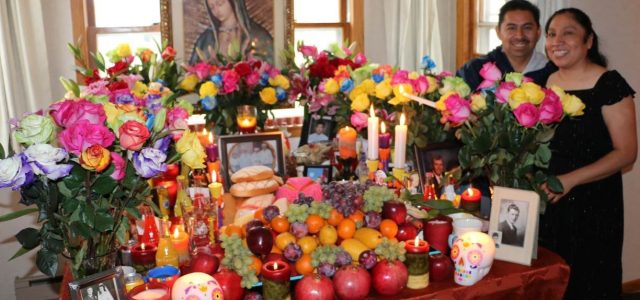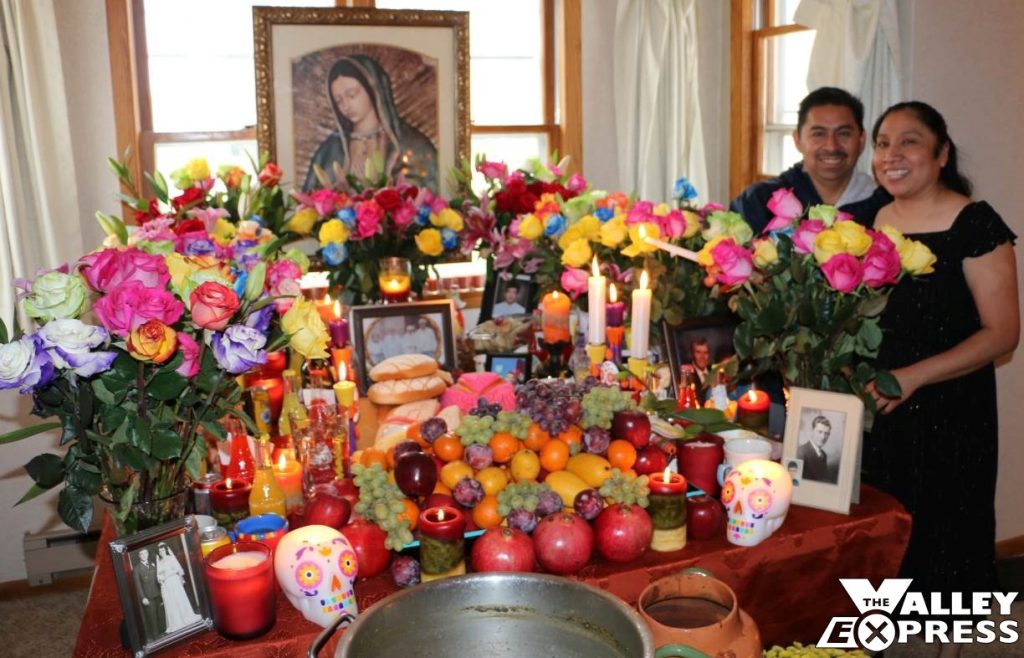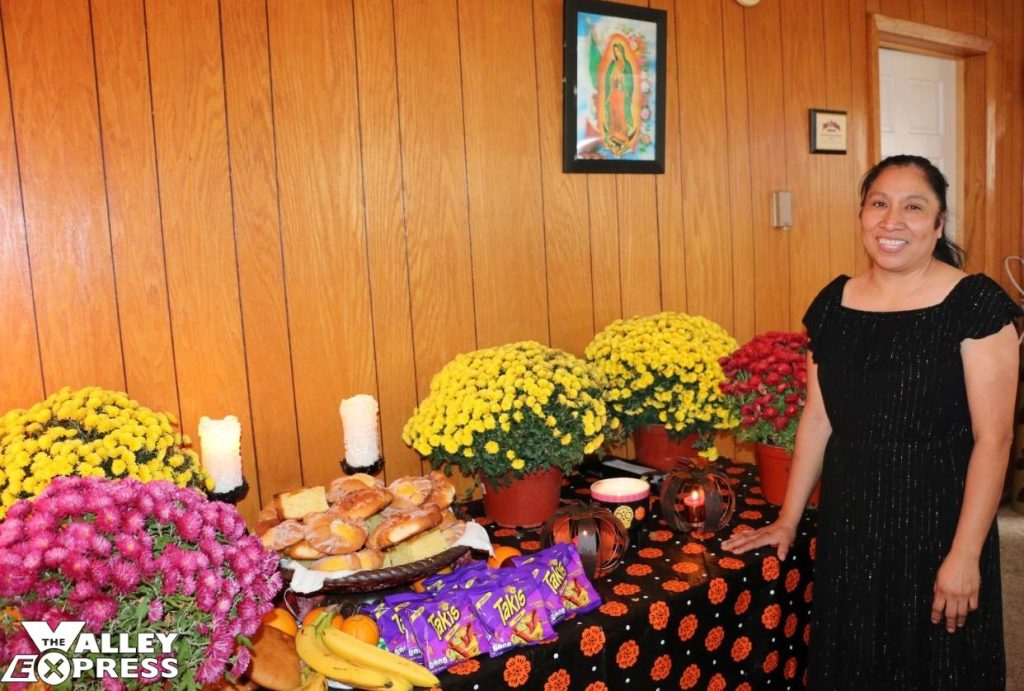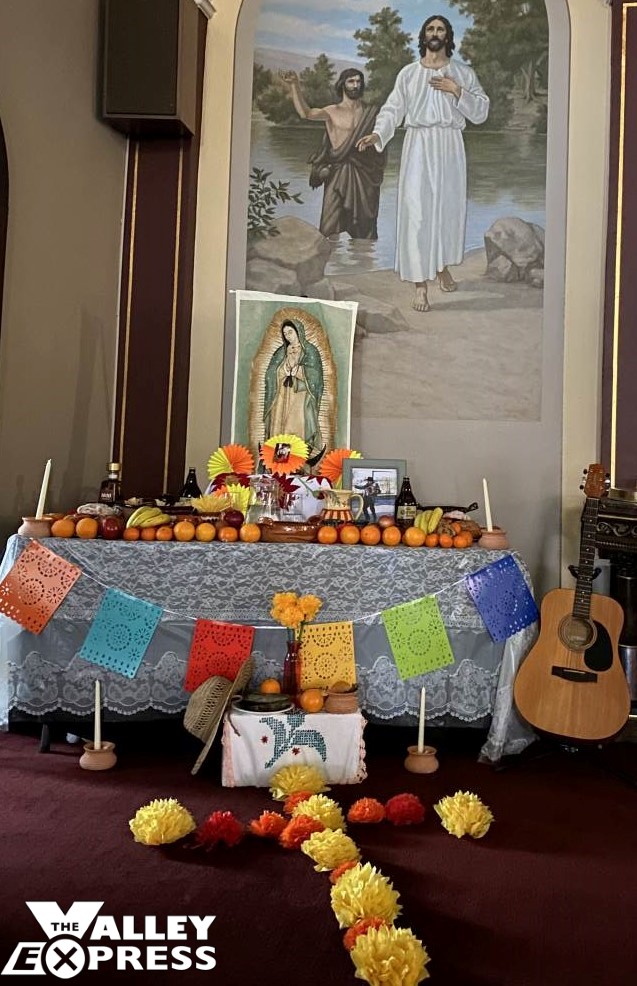

Pots of marigolds line the way and marigold petals are scattered across the path that leads to Esther and Jeorge Ramirez’s tidy house in Milbank. A welcoming glow emanates from the doorway. Esther stands vigil inside waiting to greet her guests, but invitations have not been sent. Everyone in town is welcome. Esther, however, knows the crowd will be sparse. She no longer lives in Mexico and the Day of the Dead or Dia de los Muertos is nearly unknown in Milbank.
As I step inside, I realize the glow was radiating from candles clustered on tables around the room and placed on the gigantic display filled with colorful flowers they call an ofrenda (private altar). Esther is also glowing and eagerly begins to help me navigate this new cultural territory.
She bubbles with enthusiasm and, though her English is better than my Spanish, she struggles to explain everything at once. One of the first things she sets straight is that Dia de los Muertos is not Mexican Halloween. She explains the holiday is not scary or morbid. “It’s a happy celebration to honor our ancestors. It’s not solemn or sad, it’s all about hospitality.” (Happy is a phrase that will be repeated many times during my visit.)
She says people gather to pay their respects and remember friends and family members who have died. The tradition is to build the ofrendas and fill them with the foods and beverages that were favorites of the deceased. Along with the flowers, photographs, memorabilia, and special items such as toys for the children or los angelitos (little angels) the ofrenda commands attention.
The Dia de los Muertos has deep roots in Mexican history and in particular their Aztec heritage. Esther says,” Jeorge and I are from the real native people. We don’t speak Spanish. We speak Nuhuatl.” Classical Nuhuatl has been spoken since at least the seventh century CE and today many dialects, influenced now by Spanish, continue to be spoken in central Mexico and along the coast.
The ancient Aztecs observed Dia de los Muertos as a month-long celebration. Over 2000 years ago, Aztecs placed skulls on temples to honor their dead. Others would decorate tree stumps and place offerings there as an homage to their ancestors.
After colonization occurred, the Aztec rituals were Christianized and were linked to the Catholic observances of All Saints Day and All Souls Day. In the 17th Century they started using clay to mold the skulls and sugar — something that was readily available and plentiful — to decorate them.
But, the hope and main purpose of the holiday remained the same. Dia de los Muertos is intended to encourage the souls of the departed to return for a brief visit once each year. Esther emphasizes they believe the family member returns to be amongst them for the celebration. It is not symbolic. ”They are present with us,” she affirms.
When Esther lived in Mexico, she was part of her mother’s Dia de los Muertos celebration. But, after she married, she began to take on the responsibilities for her family’s observance.

Now, the family spirits visit her house. She explains the reason for the marigold petals on the sidewalk is to help them find her house. The marigolds or cempasúchil and their strong scent are thought to attract and lead the souls to the offerings. Esther says, “ It is the way the spirits know to follow. It lets them know to come in. We call it the pathway.”
The Dia de los Muertos celebration encompasses three days — from noon on October 31 until noon on November 2. The first 24 hours are devoted to the spirits of the children, the second is for the spirits of the adults, and the third is open for all the spirits.

On the first day, the gates of heaven are opened and the spirits of the children who have passed away are allowed to reunite with their families. Esther and Jeorge’s ofrenda for the children contained candy, marshmallows on a stick, pastries, and toys. Esther says, “After the spirits have been here for a few hours, then people can take the treats. Children can’t play near the ofrenda, though. They are taught respect.”
When the ofrenda for the los angelitos was removed, it was replaced by one for the adult relatives. This year, they honored Esther’s father, Esther’s sister, Doug and Linda Buri’s parents, Jerry Bury’s parents, and the grandfather their son’s girlfriend.”
Along with the candles and dozens of roses, some of the favorite things piled on the ofrenda were: soft drinks, fruit, special bread — Pan de Muertos— made by Esther, tequila, cigarettes, and a tray of pecans. The pecans were for Esther’s father. She says, “None of the food or items can be touched for at least three hours because they provide a banquet for the spirits.”
On Monday, the family placed dozens of homemade tamales on the altar, and on Tuesday morning, they treated the spirits to steaming hot chocolate. Esther explains all the items on the ofrenda must be new and the food must be appetizing and perfectly prepared for someone to eat. She also cautions, “We do not smell the food and flowers before placing them on the ofrenda. It is all for the spirits to enjoy.”
She describes the tone of their customs as a happy time with reverence. She adds, “Happy and sad is how I feel. Happy waiting for them and making sure we have what they enjoy. We can feel them being here.” She also explains that someone must always stay at home during the three days to welcome the spirits and be with them.
“The spirits like to give signs when they are here. The spirits are here to help you,” she insists, “but you have to be happy to communicate with them. You can see if they are mad or don’t want to be here. If you try to light a candle for them it will not light. It shows they are mad.”
Their son and his girlfriend came from California for the celebration. This is the first time Jorge’s girlfriend experienced Dia de los Muertos . “She is Hispanic,” Esther says, “but her family doesn’t do the tradition because many Hispanics from the northern states don’t carry on the tradition.”
In Mexico, though, she says “ Nobody works during these three days. It is a huge holiday. Not a little one but a BIG one. The president stops working. Everyone celebrates.”
“I stay home from the restaurant (she owns Guadalupe’s Mexican Restaurant in downtown Milbank) because it is only these three days of the year we do their favorite food, their favorite things. It’s a very important time. If we don’t do this or skip a year, the spirits disappear and never come back.”
The men’s job is to make the table and the candle holders. Jeorge says, “If we were in Mexico, we would go out and cut the things to make the tables. We might use a cactus to hold the candles. In Mexico, we use everything natural.” The tables are always made and not just appropriated from another part of the house. Usually, it is the women who cook the chickens and pigs and bake the special pastries.
Calaveras, which translates to skulls in English, are one of the best known symbols of Dia de los Muertos, and several brightly colored skulls stand on the ofrenda. The skulls are created by adding white sugar and meringue powder to molds and the finished calaveras often are decorated and emblazoned with the name of each person honored.
If you have seen the Disney movie Coco, you might imagine everyone who attends paints their face like a skull. This is a new aspect of the holiday and not part of Esther’s tradition. It got its start in 1910, when the Mexican cartoonist, Jose Guadalupe Posada, was ridiculing the skulls, and the image caught on and later became commercialized.
Guadalupe Posada is credited with introducing the iconic image of the feathered La Calavera Catrina, but artist Diego Rivera, who created a mural in the historic center of Mexico City, ensured Catrina would become a perennial addition to Day of the Dead festivities around the world.
Esther shrugs at these and some of the other changes that, in her view, have eroded the holiday’s meaning. She says, “My Dia de los Muertos is very traditional. I do the three days like the original. Some now just do one day.”
Esther gently repeats, “ I want people to know it is not something bad, but something nice, good. We are doing it for the people who are gone. We are remembering them. They are here with us.”
She says, “In Mexico, even if you are poor, you put out one pot of marigolds and wait. Every classroom in school makes an ofrenda with a picture of Our Lady of Guadalupe and they make a cross with marigolds.”

Things are changing in our area, too. Esther says, “Sister Rosemary, who served in Mexico for many years, attended our Dia de los Muertos celebration on Monday night and performed Mass at our home. And, for the first time, an ofrenda was built for St. Lawrence Church in Milbank. The ofrenda at St. Lawrence features delicate hand cut paper (papel picado). The holes in the vibrantly-colored art pieces symbolize air — one of the four elements of life– and a way for the spirits to get through. Their colors are also significant. For example, yellow is for purity and purple for the Catholic faith, but the meaning of the colors changes for different occasions.
When the celebration concludes at noon on the third day and the spirits have returned, Jeorge and Esther gather all the flowers and take them to the cemetery and the Catholic church. If they were in Mexico they would go to the graves of the people who had been honored. It presents another chance to socialize and reminisce about the departed. Some people play cards or music, and the time often involves cleaning the gravestones and tending to the cemetery.
“After today, I feel more powerful,” Esther says. “ I think about Dia de los Muertos for the whole year. What will I do next year for the visitors? I hope someday others will bring their pictures and join us. Everyone is welcome!”
“We will be waiting for you next year,” she says. “ If I’m here, I’ll be doing it again next year. If not, I’ll see you in heaven!”













No comments so far.
Be first to leave comment below.